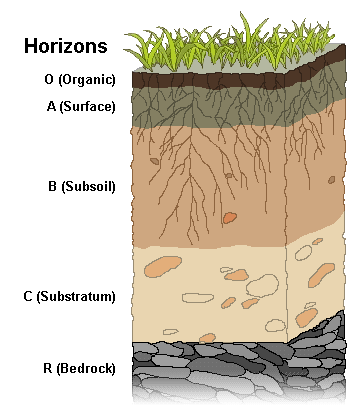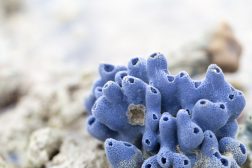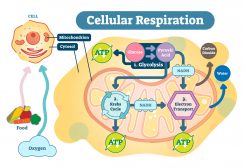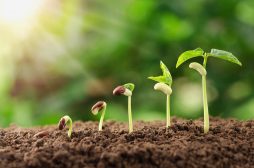Soils

Young plant growing from the soil.
Table of Contents
Where a plant grows and what resources are available to it is of vital importance to the life of a plant. The soil type and quality can be the difference between survival and termination of a plant. Soil is a very dynamic and complex portion of the earth’s crust. In some places, the soil is only a few centimeters thick, while in others it is hundreds of feet deep. In the grand scheme of things, the soil is vital not only to us as humans, but also to the existence of nearly all living organisms. Soil contributes to the plants that grow in it, just as the growing plants give back to the soil. It is a point of dynamic exchange between the living and non-living components of the earth.
The soil as what it is today is a result of many factors coming together: climate, parent material, local topography, vegetation, living organisms, and, of course, time. All of the factors can be involved in various degrees, which is why there are many thousands of soil types. The solid bulk of soil consists of minerals and organic matter. In between the solid particles are pore spaces, which are filled with varying amounts of air and water. The pore sizes and how they are connected within the soil bulk, determine the quality of soil aeration. Aeration refers to how water and air are held within a soil sample.
Soil Profile
In looking closer at soils, it is important to understand that there are general regions or horizons of soil development that are usually obvious in an undisturbed area. For example, if we found an undisturbed area, and dug down 3 to 6 feet (1 or 2 meters), we would likely find a soil profile (cross-section of the horizons) of three integrated horizons. The composition and stage of development will obviously vary widely depending on where the soil profile is taken. The top horizon is called the A horizon or topsoil. This horizon is usually 4 to 8 inches on average, again depending on where your sample is from. The A horizon is further subdivided into a darker upper portion, called the A1 horizon and a lighter lower portion A2 horizon. The A1 horizon contains the majority of the organic material out of the three integrated horizons. The next horizon is the B horizon or the subsoil. This is usually 1 or 2 feet deep on average. The subsoil usually contains more clay, so fewer pore spaces, and is lighter in color than the topsoil. The lowest horizon is called the C horizon and it could be 4 inches to 10 feet deep or it may not be present. The C horizon is called the soil parent material and it extends down to bedrock.

Soil Parent Material
As a quick review, soil development is first predicated on the formation of the parent material. Parent material accumulates via the weathering of igneous, sedimentary, and metamorphic rocks. Igneous rocks are ones from volcanic activity, sedimentary rocks are formed from glacial deposits, water or wind action, and metamorphic rocks are ones formed from the other two types after undergoing extreme pressures and heat deep within the earth. These three types of rocks would require separate tutorials of their own for complete understanding. However, for now, just realize that these three rock types are the basis for the development of soil.
Factors
Climate
The climate is a globally varying feature and weighs heavily upon the weathering of rocks for soil parent material. For example, in desert or arid regions, there is little rain weathering and the soils are poorly developed. In contrast, areas of high liquid precipitation result in well-developed soils. In areas where the temperature ranges widely, rocks may split and crack and cause rock breakdown. It is important to understand that the climate plays a direct role not only in ensuring water resources to plants, but also the soil resources to plants.
Organic composition and living organisms
In addition to nematode activity, the bacteria and fungi present in the soil decompose all sorts of organic material, such as leaves, dead roots, and animal carcasses. Living organisms and their organs, such as roots, produce carbon dioxide, which combines with water and forms an acid. The acidic nature results in a higher dissolving rate for the minerals present in the soil. Bacteria, fungi, nematodes, birds, ants and other burrowing insects all serve as composters for topsoil. As these organisms alter the soil through their activities, they add to it with their wastes and the decomposition of their bodies when they die. The organic composition of soil depends on external factors, such as location and water resources. If an area is constantly wet, and oxygen is limited or lacking in the soil, the microorganism activity may be quite low and the organic content may be as high as 90%. Thus the organic content in that soil will be quite high. On average, topsoil might be composed of 25% air, 25% water, 48% minerals, and 2% organic material. Furthermore, with the exception of legumes and a few other plants, almost all of the nitrogen needed by growing plants, and most of the phosphorus and sulfur come from the decomposition of organic matter. As the decomposition progresses, the acid content increases which in turn increases the breakdown of minerals which will be carried into solution into growing plants.
Local area topography
Topography refers to the surface features of an area. For example, if an area is a steep soil that is weathered from parent material may quickly wash away or erode through the actions of wind, ice, and water. On the other hand, if an area is flat and poorly drained, water may pool in slight depressions after it rains. This lack of drainage could result in interrupting the activities of microorganisms in the soil. Thus soil development is stopped. An ideal set of surface features would be ones that allow for soil drainage without erosion.
Mineral composition and soil texture
The size of the individual soil particles is called soil texture. The three general designations are sand, silt, and clay. Generally, sands and gravels are composed of many small particles bound together chemically or by a matrix of cementing material. Silt is composed of finer particles that are usually too small to see without a hand lens or microscope. Clay particles are even smaller yet. They are visible individually with an electron microscope as even a powerful light microscope will not render them visible. Clay particles are individually called micelles. These particles are negatively charged, sheet-like, and held together by chemical bonds. Because of their negative nature, they attract, trade or capture positively charged ions. The water that adheres tightly to the particle surface acts as a binding agent and a lubricant. This lends to the plastic nature of clay. Clay is also a colloid, meaning it is a suspension of particles that are larger than molecules, yet do not settle out of a fluid medium. The fluid medium is generally water. These three particles in various balances comprise the bulk of soil.
Soils are sometimes referred to as heavy and light. Light soils have low clay content and high sand content; heavy soils have a high clay content and low sand content. Clay soils have a high water content as they do not allow water to pass through between the particles, recall that water is a binding agent in clay. Sandy, or coarse-textured, soils do not retain much water. Organic matter and clay store more plant nutrients in the form of ions than sand and silt. The smaller clay and organic particles have a greater total surface area for the attachment of ions compared to an equal volume of sand and silt particles.
Soil structure
Soil structure refers to aggregates. Aggregates are formed as a result of the arrangement and grouping of soil particles. Sand and gravel aggregates do not demonstrate cohesion very well. In most good agricultural soils, aggregates that stick together form readily. The structure of the soil aggregates forms when colloidal particles clump together. The clumping is usually a result of the activities of soil organisms and temperature changes resulting in freezing and thawing. Without a coating of organic matter, the individual granules will continue to clump until they are clods.
Good agricultural soils are granular with many pore spaces, occupying between 40% and 60% of the total soil volume. Recall how important pore spaces are to aeration and drainage. Air and water are trapped within these pores and if the pores are numerous but small and poorly connected, as in clay soils, the restricted movement does not allow for good drainage or aeration. Furthermore, when the pores are full of water and air is not able to move in, plant roots suffer as there is not enough oxygen for root growth. Sandy soils, on the other hand, have their problems as well. For one, the large pores allow gravity to drain water out of the soil as soon as the pores are filled. As the water drains, the pores fill with air, which in turn speeds up nitrogen released by microorganisms. Much of the nitrogen released is lost as plants cannot utilize nitrogen that quickly.
Contrary to popular habit, watering can severely damage plants. Mainly, too much water leaches minerals and slows mineralization processes with anaerobic conditions (due to the reduction or lack of free oxygen). Overwatering can slow the release of nitrogen, which interferes with plant growth and speed up the breakdown of nitrates.
Water in the soil
There are three forms of water occurring in soil. Hygroscopic water is unavailable to plants because it is physically bound to soil particles. Gravitational water is the water that drains from pore spaces after rain. Plant growth can be affected if drainage is poor. Capillary water is the main source of water for plant needs. This is the water held in soil pore spaces against the force of gravity. Both the structure and organic material composition of the soil enable the soil to hold water in this manner. Vegetation density and type and the location of underground water tables are the determinants of how much capillary water is available to the plant.
Following rain or irrigation, gravity drains water away from the soil. The field capacity of the soil is the amount of water remaining after such a draining. This characteristic is mainly determined by the texture of the soil, however, structure and organic material content also play a role. When soil is at or near field capacity plants will readily absorb water. In the process of soil drying, the film of water around each soil particle becomes thinner and more tightly bound to the particle. As the water film binds to the particle, the likelihood of the water entering the root is lessened. A point of no return is eventually reached if the water is not added to the plant. This point is called the permanent wilting point and refers to the soil moisture. It is at this point that the plant is unable to absorb water at a rate sufficient for its needs. The plant wilts and will die. The permanent wilting point in clay soil is reached when the water content drops below 15%. In sandy soils, this point can be as low as 4%. The soil water between field capacity and the permanent wilting point is called available water.
Earlier we mentioned that the breakdown of minerals lends to the acidity of the soil. It is important to understand that the pH, acidity, or alkalinity of soil affects both the soil and the plant in a variety of ways. Soil that is not balanced, that is either too acidic or too alkaline, may be toxic to roots. However, normally an unbalanced soil pH will affect nutrient availability before they will affect the plant directly. In general, when soil is acidic the nitrogen-fixing abilities of plants are affected. Alkalinity will affect the availability of minerals such as copper, iron, and manganese. In areas of high precipitation, the soil is usually acidic because alkaline components are leached from the topsoil. Many agricultural operations will counterbalance any soil imbalances by adding lime (compounds of calcium or magnesium) to balance acidic soil, or by adding sulfur to alkaline soils. Bacteria in the soil will convert the sulfur to sulphuric acid, which will lower the overall pH which will make the soil more acidic. Nitrogen-based fertilizers may have the same effect on alkaline soils.
It is a fine balance to have, but soil quality directly influences plant quality.
Soil Mineral Components
Different soil minerals and their diameter range in mm as Classified by U.S.D.A.:
- Stones: > 76 mm
- Gravel: 76.0 mm-2.0 mm
- Very Coarse Sand: 2.0 mm-1.0 mm
- Coarse Sand: 1.0 mm-0.5 mm
- Medium Sand: 0.5 mm-0.25 mm
- Fine Sand: 0.25 mm-0.10 mm
- Very Fine Sand: 0.10 mm-0.05 mm
- Silt: 0.05 mm-0.002 mm
- Clay: <0.002 mm
You will also like...

Primitive Animals
Life, as we know it today, is presumed to have started in the sea and many of them were likely eukaryotic animal-like or..

The Conscious & Unconscious Nervous System
This tutorial elaborates on how the nervous system works, particularly at the tissue level of the brain. There are three..

Sigmund Freud and Carl Gustav Jung
In this tutorial, the works of Carl Gustav Jung and Sigmund Freud are described. Both of them actively pursued the way h..

Cell Respiration
Cell respiration is the process of creating ATP. It is "respiration" because it utilizes oxygen. Know the different stag..

Lights’ Effect on Growth
This tutorial elaborates on the effect of light on plant growth. It describes how different plants require different amo..

Indicator Species and Endangered Species
Certain species are capable of expressing characteristics indicative of the state of the ecosystem they occupy. They are..
